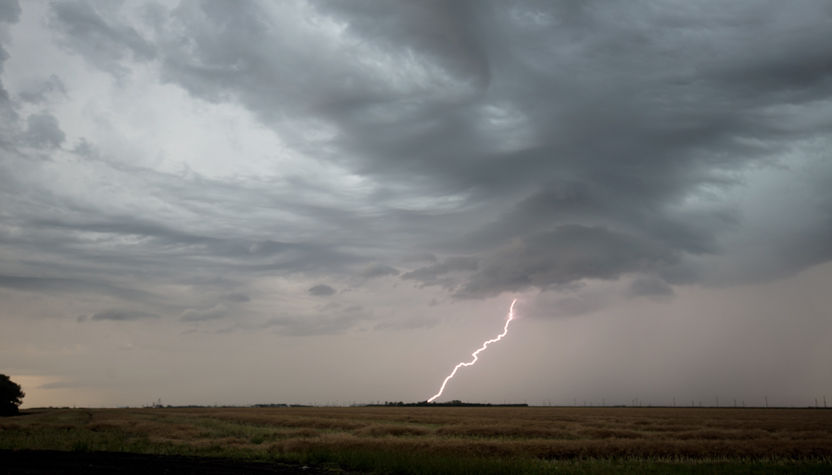Scientists Developing Soybeans for a Wider Range of Environmental Conditions

By Shari Narine
Work underway by Agriculture Canada to help soybeans combat lack of moisture could help growers take advantage of climate change in Western Canada.
“Change in temperature is not a big deal for growing soybeans. It’s not like canola or cereals that are susceptible to heat stress. It’s much more heat tolerant. The concern is in the moisture,” says Dr. Malcolm Morrison, research scientist and crop physiologist, with Agriculture Canada’s research and development centre in Ottawa.
Tracking precipitation on the prairies from 2000 to present day indicates an increase in moisture. Wetter springs may delay seeding, but on the back end dryer, warmer falls and later frost provide a longer window for harvest. But wetter springs will not always be the case. Climate change is leading to wider fluctuation in precipitation, says Morrison, which in turn means drought-like conditions for extended periods of time during the growing season.
Morrison says Agriculture Canada, both in Ottawa and in Lethbridge, are working “on lots of different things” to address the issue of precipitation as soybeans are sensitive to drought stress.
“Anything you can do to improve drought tolerance…will be a benefit to the producer because at some point in time during the growing season, you’re going to have drought stress,” he says.
Morrison defines drought stress as a period of more than two weeks where less than five millimetres of rain is received. The timing of that two-week plus period makes a difference to the crop. If it occurs when seeds are developing or during flowering it will likely lead to a decrease in yield. Drought during seeding has less impact if there is enough soil moisture to get the seeds up, and drought past seed development is of no concern.

Dr. Yvonne Lawley, soybean agronomist at the University of Manitoba, agrees that dry weather will present a challenge for soybeans, as they continue to be grown west of Ontario.
“Soybeans are a larger seed than some of the small seeded crops that we’re used to working with (and) they need to take up a lot more moisture,” says Lawley. “I saw in my research plots more variability because of that dryness in terms of plant emergence.”
She notes that as soybeans are a longer maturing crop, they need moisture later in the season as well to obtain optimal yield. In Western Canada, late rainfall isn’t part of the usual pattern, which in turn presents ideal conditions for harvesting other crops.
But soybean producers do not need to rely solely on Mother Nature to meet those precipitation marks, says Morrison.
Crop rotation, stubble management, and minimum tillage can all help retain moisture early in the season.
“Soybeans do well under minimum tillage. If you can trap an additional two to five centimetres of water in the spring from the winter snows, I think that this would be a benefit,” says Morrison. He adds that more work needs to be done on these management techniques.
Lawley has concern with new tillage practices.
“Don’t worry about temperature. Worry about precipitation. We’re trying to find varieties with improved drought tolerance. We’re trying to develop screening systems to do it.”
“I see a bit of a compromise there because as this crop moves into western Manitoba and Saskatchewan, we’re moving into areas where we’ve had no till and farmers have been using no till to conserve soil moisture to make sure they have it at the end of the season. But because they’re concerned about soybeans maturing and getting them planted into warm soils early, people are using strategic tillage for their soybeans. So we may be compromising the ability to have that moisture at the end of the season if we need it,” she says.
Morrison says in order to grow soybeans in Western Canada, a minimum of 260 mm of in-season rainfall is needed along with 2,250 to 2,300 crop heat units, which is a combination of temperature and growing days. In southern Manitoba producers could probably get away with growing 120-day soybeans, but such would not be the case in Saskatchewan or Alberta, he adds. Days of growth vary depending on the location of the crop and type of variety that is grown.
“As the number of heat units required for maturation increases, so does the yield, and farmers tend to want to hedge their bets and grow a slightly longer season crop… and I think they kind of do this with soybeans a bit in Manitoba. But they haven’t been caught yet, so that’s good,” says Morrison.
Soybean varieties are getting more and more attention, he says. Agriculture Canada is working with soybean breeder Elroy Cober, who is specifically looking at a short season soybean for food type. Private companies are working on soybean varieties for crushing and industrial use.
Morrison contends that soybean growers on the Prairies don’t have to be concerned about temperature variations. Climate change models he has seen indicate that temperature in the west will increase an average of 2 degrees Celsius. Soybeans are a temperate to tropical crop.
“We’ve made it a short-season crop, but it still likes warm temperatures,” he says.
Soybeans like temperatures up to 32 to 34 degrees Celsius in the vegetative state. However, temperatures over 28 degrees Celsius can present issues with fertility and seed set and also concerns during flowering.
The bottom line is, says Morrison, when it comes to climate change, “Don’t worry about temperature. Worry about precipitation. We’re trying to find varieties with improved drought tolerance. We’re trying to develop screening systems to do it.”


